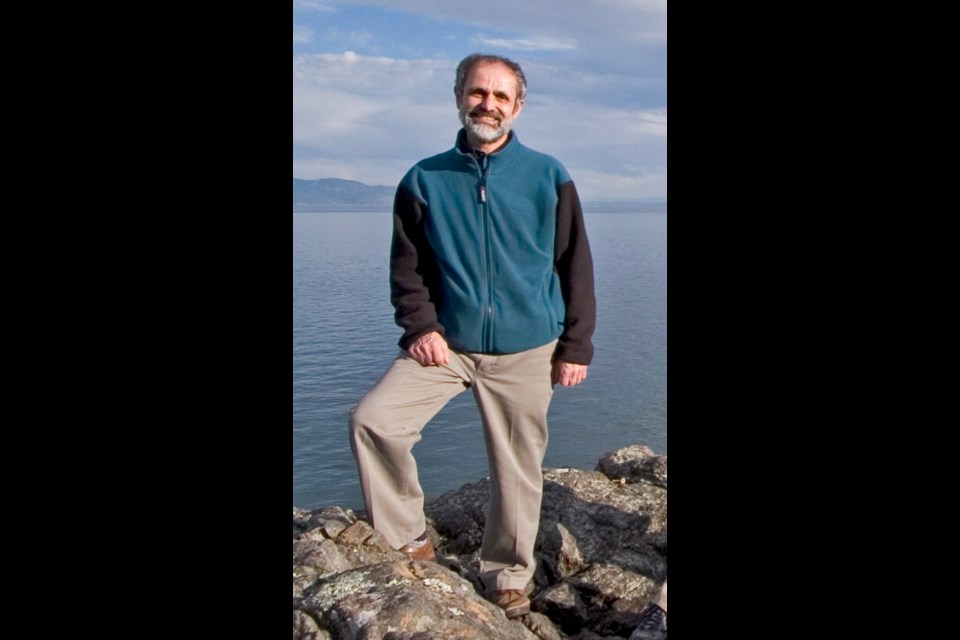Oceanographer Ken Denman sees evidence of the changing North Pacific Ocean all along Vancouver Island’s coast.
During a trip with friends this August from Swartz Bay to Salt Spring Island and then across to Crofton, there was a noticeable difference on the last leg of the ferry.
His favourite species — a microscopic plant called emiliania huxleyi that typically blooms in open ocean waters — was blooming in the inland waters of the Strait of Georgia. The water was bright green.
“Between here and Swartz Bay, the water was fine. But then, between Vesuvius and Crofton, there was a huge bloom. We got there and it just looked like a glacial lake,” he said.
Individual species are reacting to major changes in the North Pacific, he said. But with several significant changes taking place at once, it’s difficult to know which is responsible for any particular reaction.
“We know the water is getting warmer, we know it’s getting more acidic, we know the dissolved oxygen is decreasing in sub-surface water. But when these kinds of things happen, we don’t necessarily know which was the cause, or which combination was responsible,” Denman said.
Another local example is the mass die-off of starfish — the cause of which is still unconclusive.
Denman, who has studied the North Pacific for more than 40 years, will give a free talk Monday about how those changes are affecting our coast and what we can expect in the future.
Denman was a researcher scientist with the Department of Fisheries and Oceans for 38 years. He has also worked at Environment sa���ʴ�ý’s Canadian Centre for Climate Modelling and Analysis and was a lead author of a climate report that won the Nobel Peace Prize. He is now a semi-retired adjunct professor at the University of Victoria.
Denman conducted much of his research aboard weather ships at Ocean Station Papa, which is located about 1,500 kilometres west of Vancouver Island. The station is an important part of the Line P program, which has collected data at about 25 ocean locations since 1956.
“It’s one of the longest, if not the longest, time series in the open ocean. So we’re very lucky that people have had the foresight to start this so long ago and maintain it all this time,” Denman said.
Ocean changes are normal, but the rate of change has accelerated significantly in recent decades, Denman said. Among the biggest changes: The ocean is getting warmer, it’s becoming more acidic and it’s losing oxygen.
The implications of each of those shifts are widespread for ecosystems and economies. For example, decreasing oxygen levels along the continental shelf off Oregon have killed many fish and shellfish, he said.
Acidification, caused by carbon emissions, is bad news for species like oysters that have body parts made of calcium carbonate, he said.
“As the pH goes down, it makes it harder for animals to form their calcium carbonate body parts. It takes more energy,” he said.
In parts of the Arctic, the water is so acidic that it is corroding those shells.
In addition to general trends, there are more temporary blips of extreme conditions, like the “blob” — a mass of warm water in 2013 and 2014 that changed the circulation of the whole Alaskan gyre and drew southern species north.
“There were areas where the surface waters were close to four degrees warmer then they usually are, which is quite astonishing. That’s a very large anomaly,” he said.
Denman said our habits are at the route of much of the change. He hopes visitors to his talk consider the importance of behaviour changes.
“We have to think about, as a society, what we’re doing. It is having an impact on the ocean.”
��
Denman will give a free public lecture, The��North Pacific — Our Ocean Is Changing and Why We Should Care, Monday at 7��p.m. at the Shaw Centre for the Salish Sea in Sidney. The lecture marks the opening of an international symposium held at DFO’s Institute of Ocean Science, celebrating the 60th anniversary of sa���ʴ�ý’s Line P monitoring of the Northeast Pacific Ocean.



